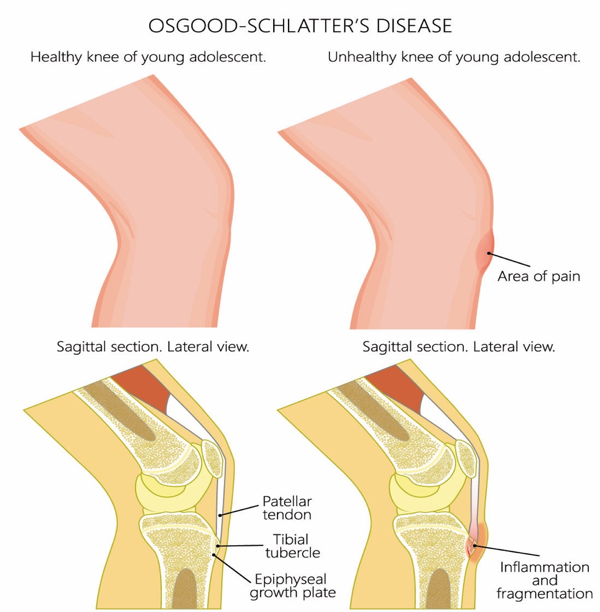
Managing Osgood Schlatter’s Disease
I’m very excited to have sat down with Dr. Ross Levine this week to discuss Osgood Schlatter’s Disease (OSD) because we have both worked with many clients with OSD. This condition presents a bit of a challenge for those who have it and live an active lifestyle, so we wanted to share some strategies for handling it with care.
Check out the video here –
When young athletes are experiencing knee pain it can be very scary for both the athlete and the parents, and they may be unsure of how to reduce pain appropriately. So, what is Osgood Schlatter’s disease exactly? First, let’s look at what occurs at the knee joint during basic movement. When we move our leg, the quadriceps muscles pull on the kneecap (the patella). The patella then pulls on a strong band of connective tissue called the patellar tendon. The patellar tendon then pulls on a bony lump at the top of your shinbone called the tibial tuberosity. All of that pulling can result in pain, swelling, tenderness, and a bony bump at the top of the shin bone for adolescents whose bones are growing faster than their muscles and tendons.

Osgood Schlatter’s is the epitome of “growing pains” that roughly 20% of young athletes suffer from. It is classified as an overuse injury that can worsen with repetitive running, jumping, and cutting. That is why the most common victims of OSD are physically active children, mainly the young athletes ranging from 9-15 years old who are undergoing growth spurts. Growth plates are layers of cartilage at the ends of bones. It is where most of a bone’s growth takes place and when the skeleton reaches maturity, growth ceases and growth plates ossify (harden). These locations where bones are still growing are known to be weaker and more susceptible to pain and/or injury and in the case of Osgood Schlatter’s disease, the growth plate at the knee joint is the culprit.
The unfortunate reality is that Osgood Schlatter’s doesn’t just go away. Doctor Bob Shrum said it best “it’s going to keep going as long as you’re growing”. Symptoms will linger until the growing adolescent has finished growing, so it’s crucial for kids with OSD who are very active to seek help from a specialist for pain management. Strength coaches need to have a solid understanding of OSD because programming for a young athlete who has it will require individualized modifications. A few factors to be mindful of when strength training someone with OSD include creating safe and effective warm-up routines, inclusion of recovery modalities, and managing playing time and rest. There is no cookie-cutter solution to remedy OSD because no two bodies are the same. Our bones, muscles, and tendons all grow at different rates, which is why it’s critical to seek an individualized, thorough evaluation from a physical therapist who can administer functional and orthopedic testing. Failing to seek help after experiencing symptoms can be a critical mistake because pain will worsen or lead to serious injury.
Michael has been a strength coach at Olympia Fitness and Performance for three years. Michael graduated from Rhode Island College where he studied Community Health & Wellness with a concentration in Wellness & Movement studies. After graduating, Mike went on to get his CSCS (certified strength and conditioning specialist) through the NSCA. He is also a Certified Speed and Agility Coach, as well as a TPI certified coach. In his three years as a strength coach, Mike has helped clients from all walks of life improve their fitness levels. He has a strong passion for helping young athletes not just improve their athletic performance, but also helping them build confidence.
Sources
- Smith, James. Varacallo, Matthew. (2020, July 29). Osgood Schlatter Disease. National Institute of Health. https://www.ncbi.nlm.nih.gov/books/NBK441995/
- Schrupp, Robert. Heineck, Brad. Bob & Brad. (2015, April 6). Top 3 Treatments for Osgood Schlatter Disease or Syndrome. YouTube. https://youtu.be/fXFRuZz_qoI

